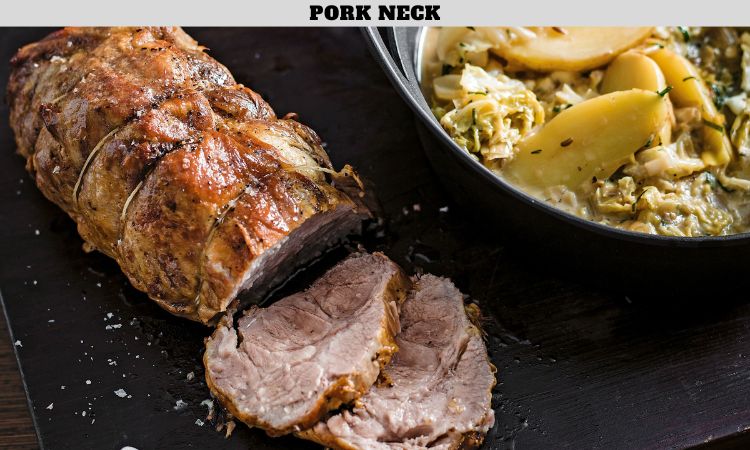Pork Neck

Pork neck, often overlooked in mainstream cooking, is a versatile and richly flavored cut of meat. Its marbled texture and succulent taste make it a favorite among chefs and home cooks alike. Whether roasted, grilled, or slow-cooked, pork neck can transform into a mouthwatering dish that satisfies the most discerning palates. Let’s dive into everything you need to know about pork neck, from its culinary uses to cooking techniques and nutritional benefits.
What is Pork Neck?
Pork neck, also known as pork collar or neck filet, is a cut of meat taken from the shoulder region of the pig. This area is characterized by its high-fat content and natural marbling, which contributes to the tenderness and flavor of the meat. Pork neck is widely used in cuisines worldwide, particularly in Asian, European, and American dishes.
The Unique Characteristics of Pork Neck
1. Marbling and Texture
The marbling in pork neck gives it a rich and juicy texture that remains tender even after prolonged cooking. This makes it ideal for methods that involve slow cooking or high-heat grilling.
2. Versatility in Cooking
Pork neck can be prepared in numerous ways, making it a versatile ingredient. It is perfect for stews, barbecues, stir-fries, and even cured products like sausages.
3. Affordable and Accessible
Compared to premium cuts like tenderloin or ribeye, pork neck is relatively affordable while delivering comparable taste and quality.
Cooking Techniques for Pork Neck
1. Roasting Pork Neck
Roasting enhances the natural flavors of pork neck. To prepare:
- Marinate the pork neck with olive oil, garlic, rosemary, and your preferred spices.
- Preheat the oven to 180°C (350°F).
- Roast for approximately 1.5 to 2 hours, turning halfway through for even cooking.
- Let it rest for 10 minutes before slicing.
2. Grilling Pork Neck
Grilled pork neck is a popular choice for barbecue enthusiasts. Here’s how:
- Slice the pork neck into 1-inch thick steaks.
- Marinate with a mixture of soy sauce, honey, ginger, and sesame oil.
- Grill over medium heat for 6–8 minutes per side or until the internal temperature reaches 145°F (63°C).
3. Slow Cooking Pork Neck
Slow cooking allows the meat to become fork-tender:
- Place pork neck in a slow cooker with onions, carrots, celery, and your favorite herbs.
- Add broth or wine for moisture.
- Cook on low for 6–8 hours or until tender.
4. Braising Pork Neck
Braising combines roasting and steaming for a robust flavor:
- Sear the pork neck in a hot pan until browned.
- Transfer to a pot, add broth and seasonings, and simmer for 2–3 hours.
Delicious Pork Neck Recipes
1. Korean-Style Pork Neck BBQ
Ingredients:
- 1 kg pork neck
- 1/4 cup soy sauce
- 2 tbsp brown sugar
- 1 tbsp sesame oil
- 1 tsp minced garlic
- 1 tsp minced ginger
Instructions:
- Combine all ingredients in a bowl and marinate the pork neck for at least 2 hours.
- Grill over medium heat until fully cooked.
- Serve with rice and kimchi.
2. Slow-Cooked Pork Neck Stew
Ingredients:
- 1 kg pork neck
- 2 onions, chopped
- 3 carrots, sliced
- 2 cups beef or chicken broth
- 2 tbsp tomato paste
- 1 tsp paprika
Instructions:
- Brown the pork neck in a skillet and set aside.
- Sauté onions and carrots in the same skillet.
- Add the pork neck, broth, tomato paste, and paprika to a slow cooker.
- Cook on low for 7 hours. Serve hot with bread or rice.
Nutritional Benefits of Pork Neck
Pork neck is not only flavorful but also rich in essential nutrients:
- Protein: High in protein, making it ideal for muscle building and repair.
- Vitamins and Minerals: Contains B vitamins, iron, and zinc, which support energy production and immune health.
- Healthy Fats: The fat content provides energy and enhances the absorption of fat-soluble vitamins.
Cultural Significance of Pork Neck
In various cuisines, pork neck holds a special place:
- Asian Cuisine: Used in dishes like Thai grilled pork neck (Kor Moo Yang) and Chinese hot pot.
- European Cuisine: Popular in German stews and Italian cured meats.
- American BBQ: A staple in smoked and grilled preparations.
Tips for Buying and Storing Pork Neck
Buying Tips
- Look for meat with bright pink color and good marbling.
- Choose cuts from reputable butchers for optimal freshness.
Storage Tips
- Store in the refrigerator for up to 3 days.
- Freeze for longer storage, ensuring the meat is tightly wrapped to prevent freezer burn.
Health and Sustainability
Pork neck can be part of a balanced diet when consumed in moderation. Opt for sustainably sourced pork to support ethical farming practices. This ensures high-quality meat and reduces the environmental impact of meat production.
Conclusion
Pork neck is a hidden gem in the culinary world, offering exceptional flavor, versatility, and nutritional benefits. Whether grilled, roasted, or slow-cooked, this cut can elevate any meal. Experiment with the recipes and techniques outlined above to discover the full potential of pork neck in your kitchen.